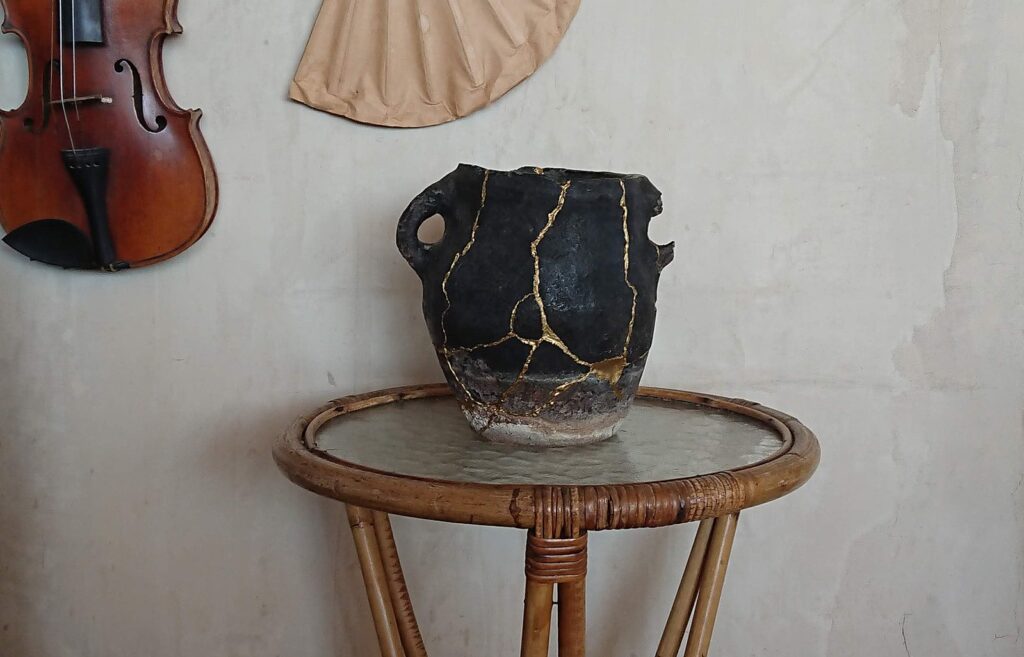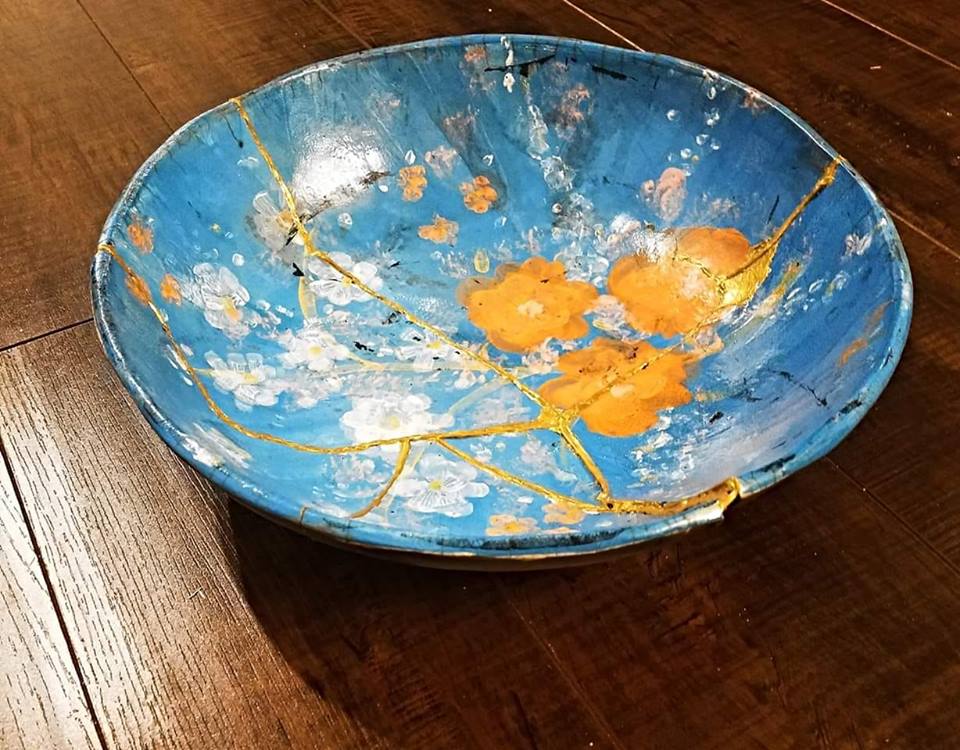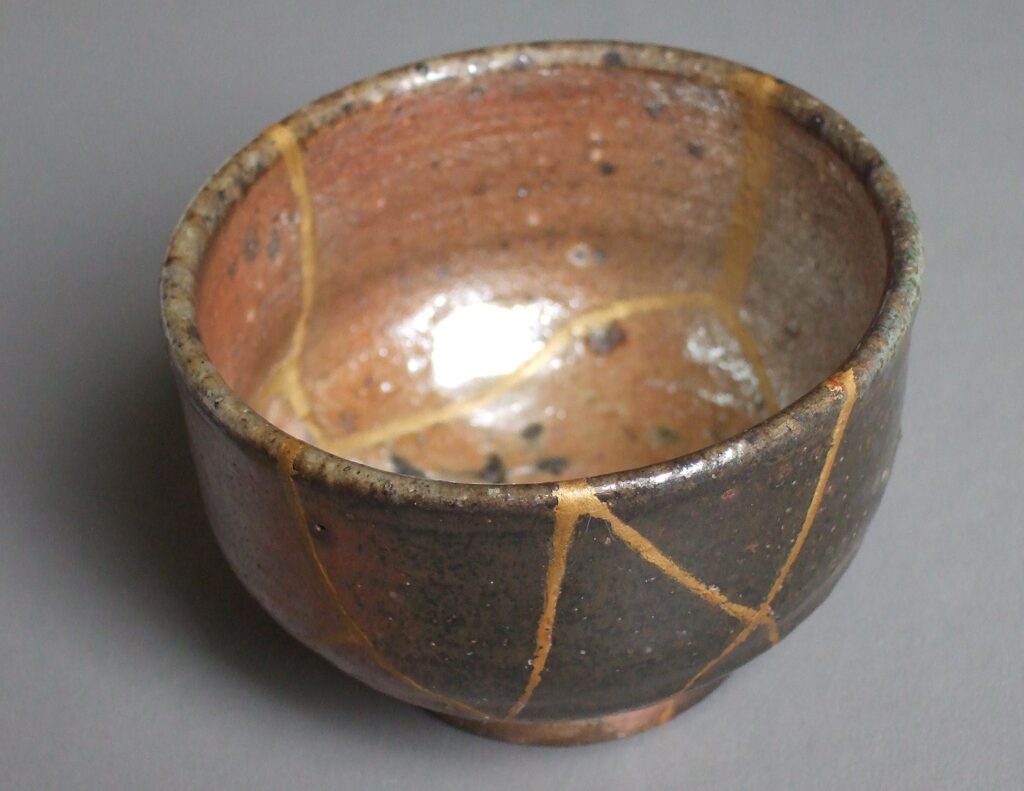In a world that often glorifies perfection, there’s something profoundly beautiful about embracing imperfection.
This sentiment lies at the heart of kintsugi, meaning golden joinery. It is also called kintsukuroi, or golden repair.
These are the Japanese art of repairing broken pottery with gold or other precious metals. It is meant to highlight imperfection and increase the value of an object rather than discarding a broken object.
More than just a technique, kintsugi embodies a philosophy that celebrates the beauty of impermanence, resilience, and transformation.

Origins and Philosophy
Kintsugi traces its roots back to 15th century Japan, during the Muromachi period. Legend has it that kintsugi originated when the shogun Ashikaga Yoshimasa sent a broken Chinese tea bowl back to China for repairs.
Displeased with the unsightly metal staples used in the repair, Japanese craftsmen sought a more elegant solution. They did this by melding the pieces back together with gold.
Thus, kintsugi was born. By the 17th century, artists were purposefully breaking pottery and repairing it using kintsugi to increase the value of their products.
At its core, kintsugi embodies the Japanese aesthetic principle of wabi-sabi. This celebrates the beauty of imperfection, impermanence, and the natural cycle of growth and decay.
Rather than disguising flaws, kintsugi draws attention to them and makes them the most striking part of a piece of art. This transforms the brokenness into a thing of beauty and places the history of an item at the forefront of its identity, redefining its worth.
Like a scar on a human body, the new markings become a memory of the past.
The Process
The process of kintsugi is both meticulous and meditative. It begins with the careful collection of broken pottery pieces, each one a testament to the object’s history and the passage of time.
These fragments are then delicately reassembled using a lacquer made from natural resins, such as urushi. This acts as a glue.
There are three main methods of kintsugi, depending on how the pottery was broken and what pieces are needed for repair.
First is the crack method. This involves using resin and gold dust to fill in the cracks in pottery and re-bind the pieces, filling in small gaps.
Second is the piece method. This is where a piece of the pottery is completely missing and it is fully replaced with a gold compound.
Finally is the joint call method. This is where a non-matching piece of pottery that is similarly shaped is inserted to repair the pottery.
Each of these methods results in the new pottery showing off its fractured form with its beautiful new scars. The result is a stunning patchwork of gold against the backdrop of ceramic, a visual testament to the object’s journey and resilience.

Symbolism and Meaning
Beyond its aesthetic appeal, kintsugi holds deep symbolic significance. Each piece repaired through kintsugi becomes a tangible reminder of the beauty that can emerge from adversity.
The cracks, once seen as flaws, are transformed into luminous pathways. They tell a story of resilience, strength, and the capacity for renewal.
People scrambled to own pieces of pottery that had been broken and so beautifully repaired.
In Japanese culture, kintsugi is often associated with the concept of “mushin,” or the mind of no mind. This is a philosophy centered around remaining unattached to material objects and accepting fate as part of the human condition.
This acceptance is at the root of understanding the broken nature of kintsugi pottery and appreciating its beauty for what it is. This makes kintsugi a perfect symbol for humanity.
Just as the broken pottery is transformed through kintsugi, so too can we cultivate inner strength and resilience in the face of life’s challenges. By embracing imperfection and acknowledging the scars of our past, we can find beauty and wholeness in our brokenness.
Kintsugi in Practice
While traditionally used to repair pottery, the principles of kintsugi have transcended their original medium. They have found resonance in various aspects of life.
In recent years, kintsugi has inspired artists, therapists, and individuals seeking to find meaning in their own journeys of healing and self-discovery. They have inspired multiple pieces of art and pop culture references.
Musicians, video game designers, and artists all have embraced the artistic style of repairing items with gold for their products. Therapists, in particular, have embraced kintsugi as a powerful metaphor for the process of healing from trauma and adversity.
By reframing their clients’ experiences as opportunities for growth and transformation, therapists can help individuals find strength and resilience in their brokenness, invoking the image that scars hold a special beauty whether on skin or ceramics.

Embracing Imperfection
In a society that often values perfection above all else, kintsugi serves as a powerful reminder that imperfection is not something to be ashamed of. Rather, it is something to be celebrated.
Just as the cracks in a piece of pottery are what make it unique and beautiful, so too is imperfection what defines human life. By embracing imperfection and practicing self-compassion, we can learn to love ourselves more fully and authentically.
Like the pieces of pottery repaired through kintsugi, people can find beauty and resilience in their own brokenness. They can emerge stronger and more whole than before, learning from a piece of beautiful artwork.
Conclusion
In a world that often seeks to conceal imperfections, kintsugi offers a refreshing perspective that celebrates the beauty of brokenness.
Through its philosophy of embracing imperfection and resilience, kintsugi serves as a powerful metaphor for the human experience. It reminds us that our scars are not something to be ashamed of, but rather something to be cherished as symbols of our strength and resilience.
As we journey through life, may we remember the wisdom of kintsugi and find beauty in our own imperfections.
References
Manzella, Kathyrn Pombriant. “Beauty in the Art of Repair: Kintsugi by David Pike.” Traditional Kyoto, December 12, 2014. https://traditionalkyoto.com/culture/kintsugi/.
Richman-Abdou, Kelly. “Kintsugi: The Centuries-Old Art of Repairing Broken Pottery with Gold.”
My Modern Met, March 5, 2022. https://mymodernmet.com/kintsugi-kintsukuroi/.